![]()
![]()
![]()
Use LEFT and RIGHT arrow keys to navigate between flashcards;
Use UP and DOWN arrow keys to flip the card;
H to show hint;
A reads text to speech;
34 Cards in this Set
- Front
- Back
|
Size of a prokaryote vs Eukaruyote |
0.5 to 5 micrometers for prokaryotes
10 to 100 micrometers for eukaryote |
|
|
Different possible shapes of prokaryote |
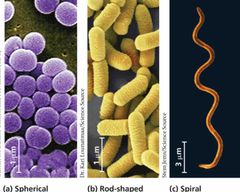
- cocci or diplococci: spherical prokaryotes and clusters -bacilli: rod shaped prokaryotes, solitary - spiral: comma-like to loose coils |
|
|
Main functions of the cell wall |
Protects Prevents from bursting in hypertonic environment Maintain cell shape |
|
|
What is a hypertonic environment and how does it affect a prokaryote? |
- when the external solution has a high solute concentration compared to internal fluids - the cell will lose water and shrink (plasmolyze), which inhibits reproduction (hence salt use for food preservation) |
|
|
What are the cell walls of eukaryotes, prokaryotes and archaea made of? |
Eukaryote: chitin or cellulose Prokaryote: peptidoglycan (polymer composed of modified sugars cross linked by short polypeptides Archaea: contains polysaccharides and proteins but no peptidoglycan |
|
|
Explain the process of Gram stain |
- difference in cell was composition - Samples are stained with crystal violet dye and iodine then rinsed in alcohol and stained with red dye |
|
|
Gram positive vs Gram negative |
Gram Positive: Simple walls with large amounts of peptidoglycan Gram Negative: less peptidoglycan with more complex walls |
|
|
Parts of prokaryote (8) |
Fimbrae: allos to stick to substrates Pilli: DNA Capsule: sticky, allows you to attach to tissues Cell wall: rigidity Cell membrane: semi permeable barrier Flagella: motility Nucleoid: Plasmids: extrachromosomal self replicting circular DNA |
|
|
What is chemotaxis? (taxis = motility) |
Prokaryotes change their movement in response to chemicals. They move toward nutrients or oxygen (positive chemotaxis) or away from a toxic substance (negative chemotaxis). |
|
|
Flagella in prokaryotes vs Eukaryotes |
Prokaryotic: - smaller - matches bacteria and archaea in size and rotation mechanism but have different molecular composition -the flagella of bacteria, archaea, eukaryote and prokaryotes arose independently form each other (they are analalogous) |
|
|
Parts of a flagella |
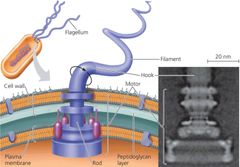
|
|
|
Bacterial Flagella |
There is over 42 different kinds of protein in the parts of the flagella (motor, hook, filament). Only half of them are actually for its function. 19 of the proteins are previously evolved proteins that did other function Exaptation: existing structure take on new functions through descent with modification |
|
|
As we know cells need to be resistant to their environment and pathogens. What are the bacteria resistant cells that they produce to survive? How is it formed? |
Endospores (developed when they lack a certain nutrient). The original cell produces a copy of its chromosome and surrounds it with a tough structure. Only killable in a lab at 121 degrees
|
|
|
Compartmentalizing in prokaryotes |
Can perform metabolic functions by storing them in compartments made out of proteins, not membrane |
|
|
Antibiotics and Ribosomes in prokaryotes |
Prokaryotic ribosomes are smaller than eukaryotic ribosomes which allow antibiotics to bind to ribosomes and block synthesis in prokaryotes but not eukaryotes |
|
|
Explain reproduction of prokaryotes. |
Binary Fission, cell divides (2 to 4, 4 to 8, to 16....) Step 1: 1 copy of circular DNA Step 2: The DNA is copied and each molecule is attached to the cell membrane. Step 3: The cell enlarges and a membrane between the attachment site forms Step 4: 2 new daughter cells are formed Asexual reproduction Probability of there being an error is 1 in 10 million = 1 x 10^-7 |
|
|
Gene recombination; vertical and horizontal gene transfer |
The combination of genes from two organisms happens in sexual reproduction for eukaryotes. Prokaryotes: - members of different species: horizontal gene transfer - movement of genes from parent to offspring: vertical gene transfer |
|
|
Transformation |
Bacteria picks up foreign DNA, including antibiotic resistance gene from the donour and incorporate's it with its own. |
|
|
Traduction |
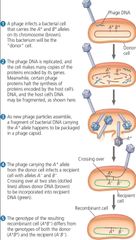
Transfer of genetic material using a bacteriophage A bacteriophage is a virus that can parasitize bacteria and inject material into it. It can't replicate because it's missing its own genetic material |
|
|
Conjugation |
DNA is transferred between two prokaryotic cells, usually of the same species, that are temporarily joined. Pillus attaches to recipient and contracts it closer, forming a temporary mating bridge where it will transfer DNA. |
|
|
F Plasmids Conjugation |
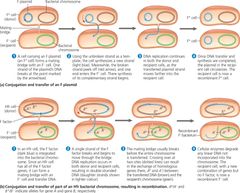
DNA donors: cell containing the F plasmid, designated F+ cells Recipient: Cells lacking F factor are F- cells.
|
|
|
F in chromosomes (Hfr) |
Donor: Hfr cell = high frequency of recombination WhenHfr cell enters a F- cell, homologous regions of the chromosomes align, allowing segments to be exchanged |
|
|
R Plasmids |
code for enzymes that destroy effectiveness of antibiotics |
|
|
Role of oxygen in metabolism (4) |
Obligate Aerobes: must use O2 for cellular respiration and cannot grow without it Obligate Anaerobes: poisoned by O2, can live by fermentation or other extract chemical energy by anaerobic respiration Anaerobic respiration: substances other than O2 accept electrons at the downhill end of the electron transport chain Facultative anaerobes: uses O2, can do fermentation or anaerobic respiration in a anaerobic environemnt |
|
|
Nitrogen Metabolism |
Nitrogen Fixation: (N2 to NH2) convert atmospheric nitrogen to ammonia (cyanobacteria), only need light, CO2, N2 and minerals to grow |
|
|
Metabolic cooperation |
Cyanobacterium Anabaena has genes for photosynthesis and nitrogen fixation but a single cell cannot carry out both because photosynthesis produces O2 which inactivates the enzyme for nitrogen fixation. Forms filamentous chains: photynthetic cells few heterocysts = nitrogen fixation |
|
|
What are biofilms and what are their cells capabale of? |
Occurs on biofilms: cells in a biofilm secrete signaling molecules that recruit nearby cells. The cells also produce polysacharides that form capsule |
|
|
Evolution in prokaryotes |
- use ribosomal RNA as marker for evolutionary relationships - use PCR to analyze genes - horizontal gene transfer is a key element to evolution |
|
|
Characteristics of Archaea vs eukaryotes vs bacteria |
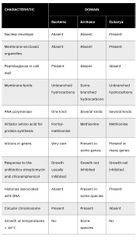
|
|
|
Extremophiles (2) |
Like extreme conditions; Extreme halophile: highly saline environment Extreme thermophile: thrive in heat |
|
|
What are methanogens? What clade will extremophiles be part of? |
Extreme halophiles, methanogens are archaea in the clade Eurychaeota. Most thermophiles belong to the clade Crenarcheota Methanogens: release of methane as by product of unique ways of archaea obtaining energy |
|
|
Chemical recycling exmaples |
- CO2 to make sugars - Fixation nitrogen produces O2 and N2 that can be used by other plants - They affect soil concentration |
|
|
Ecological interaction (8) |
Symbiosis: ecological relationship between two species Host: larger organism in symbiotic relationship Symbiont: smaller organism in symbiotic rel. Mutualism: interaction where both benefit Commensalism: one species benefits but the other is not harmed or helped Parasitism: parasite benefits at the expense of another, the host, by living either within or on the host Parasite: feed on cell contents of the host without killing it Pathogens: organism that causes diseases |
|
|
Pathogenic Bacteria |
Exotocxin: proteins secreted by certain bacteria and other organisms Endotoxin: lipopolysaccharide components of the outer membrane of gram-negative bacteria. They are released when the bacteria die and their cell walls break down |

